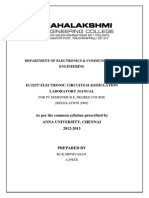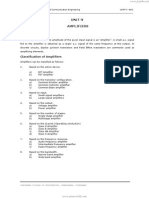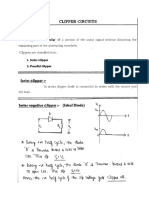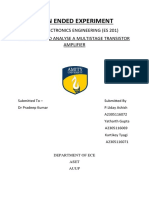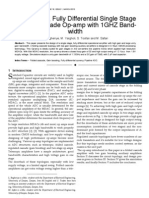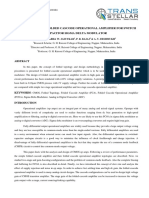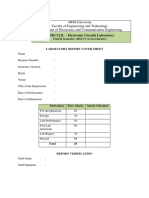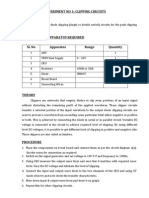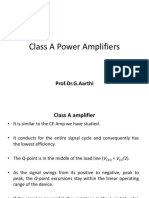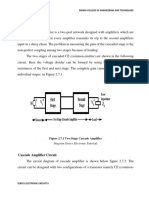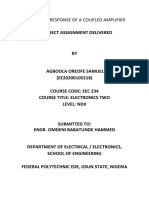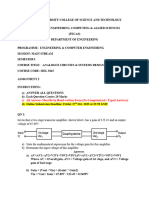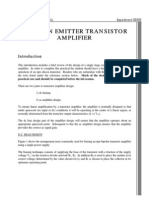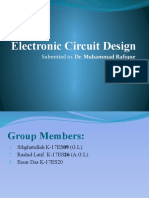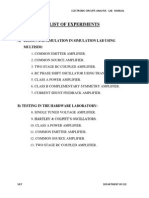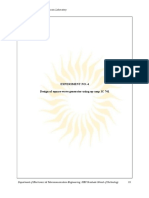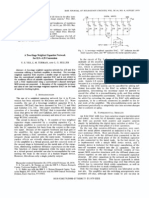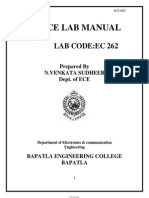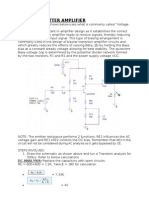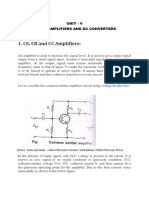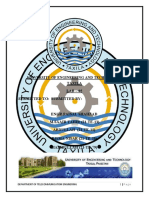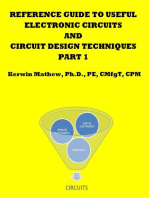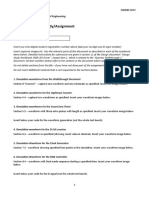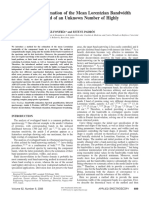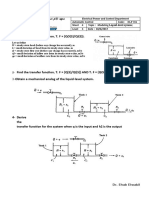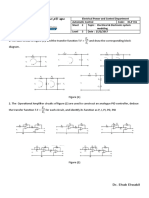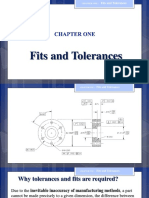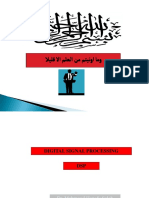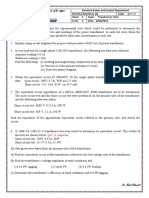Professional Documents
Culture Documents
Practical Cas Code Amplifier
Practical Cas Code Amplifier
Uploaded by
Hassan El-kholy0 ratings0% found this document useful (0 votes)
28 views5 pagesThe document describes a cascode amplifier circuit. [1] A cascode amplifier consists of a CE amplifier followed by a CB amplifier directly coupled together. [2] The schematic diagram shows the circuit components including resistors R1-R5, capacitor C1, and FETs Q1 and Q2. [3] Simulation results using Ngspice and Python show the input and output waveforms.
Original Description:
Copyright
© © All Rights Reserved
Available Formats
PDF, TXT or read online from Scribd
Share this document
Did you find this document useful?
Is this content inappropriate?
Report this DocumentThe document describes a cascode amplifier circuit. [1] A cascode amplifier consists of a CE amplifier followed by a CB amplifier directly coupled together. [2] The schematic diagram shows the circuit components including resistors R1-R5, capacitor C1, and FETs Q1 and Q2. [3] Simulation results using Ngspice and Python show the input and output waveforms.
Copyright:
© All Rights Reserved
Available Formats
Download as PDF, TXT or read online from Scribd
Download as pdf or txt
0 ratings0% found this document useful (0 votes)
28 views5 pagesPractical Cas Code Amplifier
Practical Cas Code Amplifier
Uploaded by
Hassan El-kholyThe document describes a cascode amplifier circuit. [1] A cascode amplifier consists of a CE amplifier followed by a CB amplifier directly coupled together. [2] The schematic diagram shows the circuit components including resistors R1-R5, capacitor C1, and FETs Q1 and Q2. [3] Simulation results using Ngspice and Python show the input and output waveforms.
Copyright:
© All Rights Reserved
Available Formats
Download as PDF, TXT or read online from Scribd
Download as pdf or txt
You are on page 1of 5
PRACTICAL CASCODE AMPLIFIER
1. THEORY :
A Cascode amplifier consists of a CE amplifier followed by a CB amplifier. The CE amplifier is
directly coupled to the CB amplifier. Hence a Cascode amplifier is defined as a direct coupled
CE-CB amplifier. The CE amplifier drives a CB amplifier for both DC and AC inputs. A
practical Cascode amplifier circuit consists of resistors R4 and R5 forming a voltage divider
biasing network for the FET Q2. R3 is the drain resistor for Q2 and it limits the drain current. R2
is the source resistor of Q1 and C1 is its by-pass capacitor. R1 ensures zero voltage at the gate of
Q1 during zero signal condition.
The Cascode connection is especially useful in wideband amplifier
design as well as the design of high-frequency tuned amplifier stages. The improvement in high-
frequency performance is due to the impedance mismatch between the output of the common
emitter stage and the input of the common base stage. Another important characteristics of the
Cascode connection is the higher isolation between its input and output than for a single
common emitter stage, because the reverse transmission across the compound device stage is
much smaller than for the common emitter stage.
2. SCHEMATIC DIAGRAM:
The schematic diagram of Cascode amplifier circuit in eSim is as follows,
Figure 1: Schematic Diagram of Cascode amplifier circuit.
3. SIMULATION RESULTS:
Figure 2: Ngspice Input Plot
Figure 3: Ngspice Output Plot
Figure 3: Python Input Plot
Figure 3: Python Output Plot
4. CONCLUSION:
Thus we have studied Cascode amplifier circuit using eSim and got the appropriate
wave forms.
5. REFERENCE:
http://www.circuitstoday.com/cascode-amplifier
By,
SAI PRASAD .N , THAMIL SELVAN .P.S ,
Sri Ramakrishna Engineering College,
Coimbatore – 641 022.
You might also like
- Automated Broad and Narrow Band Impedance Matching for RF and Microwave CircuitsFrom EverandAutomated Broad and Narrow Band Impedance Matching for RF and Microwave CircuitsNo ratings yet
- Analysis of CE AmplifierDocument8 pagesAnalysis of CE Amplifierramjee26No ratings yet
- Double Stage Amplifier RCDocument7 pagesDouble Stage Amplifier RCStuti BhattacharjeeNo ratings yet
- Manual MahaDocument81 pagesManual MaharameshdurairajNo ratings yet
- Unit IiiDocument16 pagesUnit Iiikannan305No ratings yet
- Ec6411 EC II Lab Manual 2013Document89 pagesEc6411 EC II Lab Manual 2013Karthik SingaramNo ratings yet
- Unit V PDFDocument35 pagesUnit V PDFkarthiha12No ratings yet
- AEC NotesDocument271 pagesAEC Notes1DS19EC726- Pankaj Ashok M.No ratings yet
- Open Ended Experiment: Basic Electronics Engineering (Es 201) To Design and Analyse A Multistage Transistor AmplifierDocument18 pagesOpen Ended Experiment: Basic Electronics Engineering (Es 201) To Design and Analyse A Multistage Transistor AmplifierudayNo ratings yet
- PN Junction DiodeDocument55 pagesPN Junction DiodeMonika SharmaNo ratings yet
- A High Gain, Fully Differential Single Stage Folded Cascade Op-Amp With 1GHZ BandwidthDocument5 pagesA High Gain, Fully Differential Single Stage Folded Cascade Op-Amp With 1GHZ BandwidthJournal of Telecommunications0% (1)
- Course: Electronic Circuit Devices Lab No: 11 Title: Cascade Amplifier CID: - DateDocument5 pagesCourse: Electronic Circuit Devices Lab No: 11 Title: Cascade Amplifier CID: - DateAamir ChohanNo ratings yet
- 2-15-1381147174-25 .Design of 1 V.FULL PDFDocument10 pages2-15-1381147174-25 .Design of 1 V.FULL PDFABHILASH RAINo ratings yet
- Lab 6 QuestionsDocument5 pagesLab 6 QuestionsAshraful Islam MridhaNo ratings yet
- SRM University Faculty of Engineering and Technology Department of Electronics and Communication EngineeringDocument13 pagesSRM University Faculty of Engineering and Technology Department of Electronics and Communication EngineeringNewton Kishore Newman MouselyNo ratings yet
- SNDT ManualDocument42 pagesSNDT ManualDhaval BhojaniNo ratings yet
- Mit Aec Labmanula 10esl37Document45 pagesMit Aec Labmanula 10esl37anon_70724250No ratings yet
- Lab - 3 - Multistage CE AmplifierDocument18 pagesLab - 3 - Multistage CE AmplifierANo ratings yet
- EE6311 LIC Lab - VidyarthiplusDocument66 pagesEE6311 LIC Lab - VidyarthiplusArun KumarNo ratings yet
- Unit IIDocument119 pagesUnit IIAman GoyalNo ratings yet
- FALLSEM2020-21 ECE2002 ETH VL2020210101764 Reference Material I 03-Sep-2020 Class A Power Amplifiers PDFDocument17 pagesFALLSEM2020-21 ECE2002 ETH VL2020210101764 Reference Material I 03-Sep-2020 Class A Power Amplifiers PDFRakesh VarmaNo ratings yet
- Rohini 84203202693Document4 pagesRohini 842032026934011 Harshada MohiteNo ratings yet
- Adc Lab Manual PDFDocument74 pagesAdc Lab Manual PDFJega Deesan75% (4)
- Ecl 302 Electronic Circuits - I and Simulation Lab - Student VersionDocument74 pagesEcl 302 Electronic Circuits - I and Simulation Lab - Student VersionSakthikumar BalasundaramNo ratings yet
- Common - Emitter Amplifier 3.1.1 ObjectiveDocument5 pagesCommon - Emitter Amplifier 3.1.1 ObjectiveQaim RazaNo ratings yet
- Fermin Energy LevelDocument13 pagesFermin Energy LevelSemiu AdelekeNo ratings yet
- Analogue CCT Analysis Design Assig 2Document13 pagesAnalogue CCT Analysis Design Assig 2Brainy B. BrainNo ratings yet
- Question Bank, 2 Marks With AnswersDocument30 pagesQuestion Bank, 2 Marks With AnswersbinukirubaNo ratings yet
- Analog & Digital Student Lab ManualDocument150 pagesAnalog & Digital Student Lab ManualMaheshwaran Mahi100% (1)
- New Analogue RepDocument4 pagesNew Analogue Repfedley sikoliaNo ratings yet
- Common Emitter Transistor Common Emitter Transistor Amplifier AmplifierDocument9 pagesCommon Emitter Transistor Common Emitter Transistor Amplifier AmplifierMauro FernandoNo ratings yet
- Assignment 1Document12 pagesAssignment 1Junaid KhanNo ratings yet
- Electronic Circuit DesignDocument83 pagesElectronic Circuit DesignSibghatullahNo ratings yet
- Design of 2-Stage Differential Amplifiers: Presented By, Bhavana ShekarDocument27 pagesDesign of 2-Stage Differential Amplifiers: Presented By, Bhavana ShekarelectronicsmastersNo ratings yet
- Ecd Lab Report 2Document7 pagesEcd Lab Report 2Saqib AliNo ratings yet
- Sharmi ECE a-D-Circuits Lab ManualDocument74 pagesSharmi ECE a-D-Circuits Lab ManualSharmila83No ratings yet
- Eca Lab Manual PDFDocument56 pagesEca Lab Manual PDFrppvch100% (5)
- Analog Communication LAB BTEC - 406 4 (ECE Branch)Document48 pagesAnalog Communication LAB BTEC - 406 4 (ECE Branch)alamgirNo ratings yet
- Experiment No. 4 Design of Square Wave Generator Using Op-Amp IC 741Document22 pagesExperiment No. 4 Design of Square Wave Generator Using Op-Amp IC 741aditi rajan0% (1)
- General Operational Amplifier Stages and Internal Circuit Diagrams of IC 741Document5 pagesGeneral Operational Amplifier Stages and Internal Circuit Diagrams of IC 741VENKATESWARLU MUVVA (PA2111004040011)No ratings yet
- Analog Circuits and Simulation LabDocument77 pagesAnalog Circuits and Simulation LableevasusanNo ratings yet
- Ec6304 Electronic Circuits-IDocument193 pagesEc6304 Electronic Circuits-IIniya Ilakkia100% (1)
- Stage 2 CapDocument4 pagesStage 2 Capnivia25No ratings yet
- Ec 262 Pspice ManualDocument69 pagesEc 262 Pspice ManualRama KrishnaNo ratings yet
- Rohini 41410934507Document7 pagesRohini 41410934507funcrusherrNo ratings yet
- Common Emitter Amplifier: DC AnalysisDocument5 pagesCommon Emitter Amplifier: DC Analysishemanshu_abbey100% (2)
- Expt 6Document3 pagesExpt 6sabitavabiNo ratings yet
- Electronic Circuits & Logic Design Laboratory: Lab ManualDocument61 pagesElectronic Circuits & Logic Design Laboratory: Lab ManualSrihari Y.sNo ratings yet
- ECA ManualDocument50 pagesECA ManualkrajenderreddyNo ratings yet
- Unit VDocument47 pagesUnit Vkd17209No ratings yet
- ECA ManualDocument62 pagesECA ManualAnonymous gP8ivl7fNo ratings yet
- BJT AC DC & MultistageDocument42 pagesBJT AC DC & MultistageJose EspinoNo ratings yet
- Ao Lab Report 5Document7 pagesAo Lab Report 5Umar Ali BaigNo ratings yet
- Reference Guide To Useful Electronic Circuits And Circuit Design Techniques - Part 1From EverandReference Guide To Useful Electronic Circuits And Circuit Design Techniques - Part 1Rating: 2.5 out of 5 stars2.5/5 (3)
- Reference Guide To Useful Electronic Circuits And Circuit Design Techniques - Part 2From EverandReference Guide To Useful Electronic Circuits And Circuit Design Techniques - Part 2No ratings yet
- Electromagnetic Compatibility (EMC) Design and Test Case AnalysisFrom EverandElectromagnetic Compatibility (EMC) Design and Test Case AnalysisNo ratings yet
- DigitalDesignStudy TemplateDocument3 pagesDigitalDesignStudy TemplateHassan El-kholyNo ratings yet
- Assignment 1modDocument2 pagesAssignment 1modHassan El-kholyNo ratings yet
- Design of High Gain Folded-Cascode Operational Amplifier Using 1.25 Um CMOSDocument9 pagesDesign of High Gain Folded-Cascode Operational Amplifier Using 1.25 Um CMOSHassan El-kholyNo ratings yet
- LAB BJT Current CircuitsDocument7 pagesLAB BJT Current CircuitsHassan El-kholyNo ratings yet
- Method For The Estimation of The Mean Lorentzian Bandwidth in Spectra Composed of An Unknown Number of Highly Overlapped BandsDocument12 pagesMethod For The Estimation of The Mean Lorentzian Bandwidth in Spectra Composed of An Unknown Number of Highly Overlapped BandsHassan El-kholyNo ratings yet
- Design and Simulation of 4T-Cascode Amplifier at 45 Nanometer Technology NodeDocument4 pagesDesign and Simulation of 4T-Cascode Amplifier at 45 Nanometer Technology NodeHassan El-kholyNo ratings yet
- Final Report - Multibody Dynamics of A Formula Student Car (2 Years Ago)Document57 pagesFinal Report - Multibody Dynamics of A Formula Student Car (2 Years Ago)Hassan El-kholyNo ratings yet
- Optimum Photovoltaic Array Size For A Hybrid Wind/PV SystemDocument7 pagesOptimum Photovoltaic Array Size For A Hybrid Wind/PV SystemHassan El-kholyNo ratings yet
- (10-21) Simulation of Grid Intgrated PV Array For-Format For ZenodoDocument12 pages(10-21) Simulation of Grid Intgrated PV Array For-Format For ZenodoHassan El-kholyNo ratings yet
- 3-Obtain A Mechanical Analog of The Liquid-Level System.: Let Us DefineDocument3 pages3-Obtain A Mechanical Analog of The Liquid-Level System.: Let Us DefineHassan El-kholyNo ratings yet
- Electrical Power and Control Department Automatic Control Code: Sheet 1 Topic: Laplace Transform Level 3 Date: 11/11/2014Document1 pageElectrical Power and Control Department Automatic Control Code: Sheet 1 Topic: Laplace Transform Level 3 Date: 11/11/2014Hassan El-kholyNo ratings yet
- Electrical Power and Control Department Automatic Control Code: Sheet 2 Topic: Electrical & Electronic System Modeling Level 3 Date: 25/2/2017Document2 pagesElectrical Power and Control Department Automatic Control Code: Sheet 2 Topic: Electrical & Electronic System Modeling Level 3 Date: 25/2/2017Hassan El-kholyNo ratings yet
- Chapter 1 (Fits and Tolerance)Document49 pagesChapter 1 (Fits and Tolerance)Hassan El-kholyNo ratings yet
- MHS11 Z TransformDocument16 pagesMHS11 Z TransformHassan El-kholyNo ratings yet
- Continuous Probability Distribution.Document10 pagesContinuous Probability Distribution.Hassan El-kholy100% (1)
- Sheet 3 (Transformer Tests)Document1 pageSheet 3 (Transformer Tests)Hassan El-kholyNo ratings yet
- Sheet 7 Routh Stability CriterionDocument1 pageSheet 7 Routh Stability CriterionHassan El-kholyNo ratings yet
- Sheet 3 (Circle Diagram)Document1 pageSheet 3 (Circle Diagram)Hassan El-kholyNo ratings yet
- Power StationsDocument16 pagesPower StationsHassan El-kholyNo ratings yet
- Lab Experiment For Transfer Function of Ac Servo MotorDocument9 pagesLab Experiment For Transfer Function of Ac Servo MotorHassan El-kholyNo ratings yet



